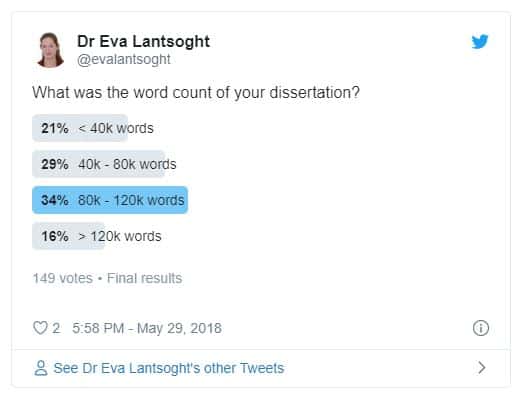
- How Long Is a PhD Thesis?
- Doing a PhD
It’s no secret that one of the most challenging aspects of a PhD degree is the volume of work that goes into writing your thesis . So this raises the question, exactly how long is a thesis?
Unfortunately, there’s no one size fits all answer to this question. However, from the analysis of over 100 PhD theses, the average thesis length is between 80,000 and 100,000 words. A further analysis of 1000 PhD thesis shows the average number of pages to be 204 . In reality, the actual word count for each PhD thesis will depend on the specific subject and the university it is being hosted by. This is because universities set their own word length requirements, with most found to be opting for around 100,000.
To find out more about how these word limits differ between universities, how the average word count from STEM thesis differ from non-STEM thesis and a more detailed breakdown from the analysis of over 1000 PhDs, carry on reading the below.

Word Count Differences Between Universities
For any PhD student writing a thesis, they will find that their document will be subject to a word limit set by their university. In nearly all cases, the limit only concerns the maximum number of words and doesn’t place any restrictions on the minimum word limit. The reason for this is that the student will be expected to write their thesis with the aim of clearly explaining their research, and so it is up to the student to determine what he deems appropriate.
Saying this, it is well accepted amongst PhD students and supervisors that the absence of a lower limit doesn’t suggest that a thesis can be ‘light’. Your thesis will focus on several years worth of original research and explore new ideas, theories or concepts. Besides this, your thesis will need to cover a wide range of topics such as your literature review, research methodology, results and conclusion. Therefore, your examiners will expect the length of your thesis to be proportional to convey all this information to a sufficient level.
Selecting a handful of universities at random, they state the following thesis word limits on their website:
- University of Edinburgh: 100,000
- University of Exeter: 100,000
- University of Leister: 80,000
- University of Bath: 80,000
- University of Warwick: 70,000
The above universities set upper word limits that apply across the board, however, some universities, such as the University of Birmingham and the University of Sheffield, set different word limits for different departments. For example, the University of Sheffield adopts these limits:
- Arts & Humanities: 75,000
- Medicine, Dentistry & Health: 75,000
- Science: 80,000
- Social Sciences: 75,000-100,000
Although there’s a range of limit, it’s safe to say that the majority fall within the 80,000 to 100,000 bracket.
Word Count Based on Data from past Theses
A poll of 149 postdocs.
In mid-2019, Dr Eva Lantsoght, a published author, academic blogger and Structural Engineering Professor, conducted a poll which asked postgraduate doctoral students to share the length of their final thesis. 149 PostDoc students responded to the survey, with the majority reporting a length falling within the ‘80,000 – 120,000 words’ bracket as seen below.

Analysis of 1000 PhD Theses
Over a three-year time period, Dr Ian Brailsford, a then Postgraduate Learning Adviser at the University of Auckland, analysed 1000 doctoral thesis submitted to his university’s library. The PhD theses which formed the basis of his analysis were produced between 2008 to 2017 and showed:
- Average number of pages = 204
- Median number of pages = 198
- Average number of chapters = 7.6
We should note that the above metrics only cover the content falling within the main body of the thesis. This includes the introduction, literature review, methods section, results chapter, discussions and conclusions. All other sections, such as the title page, abstract, table of contents, acknowledgements, bibliography and appendices were omitted from the count.
Although it’s impossible to draw the exact word count from the number of pages alone, by using the universities recommended format of 12pt Times New Roman and 1.5 lines spacing, and assuming 10% of the main body are figures and footnotes, this equates to an average main body of 52,000 words.
STEM vs Non-STEM
As part of Dr Ian Brailsford’s analysis, he also compared the length of STEM doctorate theses to non-STEM theses. He found that STEM theses tended to be shorter. In fact, he found STEM theses to have a medium page length of 159 whilst non-STEM theses had a medium of around 223 pages. This is a 40% increase in average length!
Can You Exceed the Word Count?
Whilst most universities will allow you to go over the word count if you need to, it comes with the caveat that you must have a very strong reason for needing to do so. Besides this, your supervisor will also need to support your request. This is to acknowledge that they have reviewed your situation and agree that exceeding the word limit will be absolutely necessary to avoid detriment unnecessary detriment to your work.
This means that whilst it is possible to submit a thesis over 100,000 words or more, it’s unlikely that your research project will need to.
How Does This Compare to a Masters Dissertation?
The average Masters dissertation length is approximately 20,000 words whilst a thesis is 4 to 5 times this length at approximately 80,000 – 100,000.
The key reason for this difference is because of the level of knowledge they convey. A Master’s dissertation focuses on concluding from existing knowledge whilst a PhD thesis focuses on drawing a conclusion from new knowledge. As a result, the thesis is significantly longer as the new knowledge needs to be well documented so it can be verified, disseminated and used to shape future research.
Finding a PhD has never been this easy – search for a PhD by keyword, location or academic area of interest.
Related Reading
Unfortunately, the completion of your thesis doesn’t mark the end of your degree just yet. Once you submit your thesis, it’s time to start preparing for your viva – the all-to-fun thesis defence interview! To help you prepare for this, we’ve produced a helpful guide which you can read here: The Complete Guide to PhD Vivas.
Browse PhDs Now
Join thousands of students.
Join thousands of other students and stay up to date with the latest PhD programmes, funding opportunities and advice.

Tips for writing a PhD dissertation: FAQs answered
From how to choose a topic to writing the abstract and managing work-life balance through the years it takes to complete a doctorate, here we collect expert advice to get you through the PhD writing process
Campus team
Additional links.

You may also like

Popular resources
.css-1txxx8u{overflow:hidden;max-height:81px;text-indent:0px;} Rather than restrict the use of AI, embrace the challenge
Emotions and learning: what role do emotions play in how and why students learn, leveraging llms to assess soft skills in lifelong learning, how hard can it be testing ai detection tools, a diy guide to starting your own journal.
Embarking on a PhD is “probably the most challenging task that a young scholar attempts to do”, write Mark Stephan Felix and Ian Smith in their practical guide to dissertation and thesis writing. After years of reading and research to answer a specific question or proposition, the candidate will submit about 80,000 words that explain their methods and results and demonstrate their unique contribution to knowledge. Here are the answers to frequently asked questions about writing a doctoral thesis or dissertation.
What’s the difference between a dissertation and a thesis?
Whatever the genre of the doctorate, a PhD must offer an original contribution to knowledge. The terms “dissertation” and “thesis” both refer to the long-form piece of work produced at the end of a research project and are often used interchangeably. Which one is used might depend on the country, discipline or university. In the UK, “thesis” is generally used for the work done for a PhD, while a “dissertation” is written for a master’s degree. The US did the same until the 1960s, says Oxbridge Essays, when the convention switched, and references appeared to a “master’s thesis” and “doctoral dissertation”. To complicate matters further, undergraduate long essays are also sometimes referred to as a thesis or dissertation.
The Oxford English Dictionary defines “thesis” as “a dissertation, especially by a candidate for a degree” and “dissertation” as “a detailed discourse on a subject, especially one submitted in partial fulfilment of the requirements of a degree or diploma”.
- Ten platinum rules for PhD supervisors
- Fostering freedom in PhD students: how supervisors can shape accessible paths for doctoral research
- Lessons from students on effective research supervision
The title “doctor of philosophy”, incidentally, comes from the degree’s origins, write Dr Felix, an associate professor at Mahidol University in Thailand, and Dr Smith, retired associate professor of education at the University of Sydney , whose co-authored guide focuses on the social sciences. The PhD was first awarded in the 19th century by the philosophy departments of German universities, which at that time taught science, social science and liberal arts.
How long should a PhD thesis be?
A PhD thesis (or dissertation) is typically 60,000 to 120,000 words ( 100 to 300 pages in length ) organised into chapters, divisions and subdivisions (with roughly 10,000 words per chapter) – from introduction (with clear aims and objectives) to conclusion.
The structure of a dissertation will vary depending on discipline (humanities, social sciences and STEM all have their own conventions), location and institution. Examples and guides to structure proliferate online. The University of Salford , for example, lists: title page, declaration, acknowledgements, abstract, table of contents, lists of figures, tables and abbreviations (where needed), chapters, appendices and references.
A scientific-style thesis will likely need: introduction, literature review, materials and methods, results, discussion, bibliography and references.
As well as checking the overall criteria and expectations of your institution for your research, consult your school handbook for the required length and format (font, layout conventions and so on) for your dissertation.
A PhD takes three to four years to complete; this might extend to six to eight years for a part-time doctorate.
What are the steps for completing a PhD?
Before you get started in earnest , you’ll likely have found a potential supervisor, who will guide your PhD journey, and done a research proposal (which outlines what you plan to research and how) as part of your application, as well as a literature review of existing scholarship in the field, which may form part of your final submission.
In the UK, PhD candidates undertake original research and write the results in a thesis or dissertation, says author and vlogger Simon Clark , who posted videos to YouTube throughout his own PhD journey . Then they submit the thesis in hard copy and attend the viva voce (which is Latin for “living voice” and is also called an oral defence or doctoral defence) to convince the examiners that their work is original, understood and all their own. Afterwards, if necessary, they make changes and resubmit. If the changes are approved, the degree is awarded.
The steps are similar in Australia , although candidates are mostly assessed on their thesis only; some universities may include taught courses, and some use a viva voce. A PhD in Australia usually takes three years full time.
In the US, the PhD process begins with taught classes (similar to a taught master’s) and a comprehensive exam (called a “field exam” or “dissertation qualifying exam”) before the candidate embarks on their original research. The whole journey takes four to six years.
A PhD candidate will need three skills and attitudes to get through their doctoral studies, says Tara Brabazon , professor of cultural studies at Flinders University in Australia who has written extensively about the PhD journey :
- master the academic foundational skills (research, writing, ability to navigate different modalities)
- time-management skills and the ability to focus on reading and writing
- determined motivation to do a PhD.

How do I choose the topic for my PhD dissertation or thesis?
It’s important to find a topic that will sustain your interest for the years it will take to complete a PhD. “Finding a sustainable topic is the most important thing you [as a PhD student] would do,” says Dr Brabazon in a video for Times Higher Education . “Write down on a big piece of paper all the topics, all the ideas, all the questions that really interest you, and start to cross out all the ones that might just be a passing interest.” Also, she says, impose the “Who cares? Who gives a damn?” question to decide if the topic will be useful in a future academic career.
The availability of funding and scholarships is also often an important factor in this decision, says veteran PhD supervisor Richard Godwin, from Harper Adams University .
Define a gap in knowledge – and one that can be questioned, explored, researched and written about in the time available to you, says Gina Wisker, head of the Centre for Learning and Teaching at the University of Brighton. “Set some boundaries,” she advises. “Don’t try to ask everything related to your topic in every way.”
James Hartley, research professor in psychology at Keele University, says it can also be useful to think about topics that spark general interest. If you do pick something that taps into the zeitgeist, your findings are more likely to be noticed.
You also need to find someone else who is interested in it, too. For STEM candidates , this will probably be a case of joining a team of people working in a similar area where, ideally, scholarship funding is available. A centre for doctoral training (CDT) or doctoral training partnership (DTP) will advertise research projects. For those in the liberal arts and social sciences, it will be a matter of identifying a suitable supervisor .
Avoid topics that are too broad (hunger across a whole country, for example) or too narrow (hunger in a single street) to yield useful solutions of academic significance, write Mark Stephan Felix and Ian Smith. And ensure that you’re not repeating previous research or trying to solve a problem that has already been answered. A PhD thesis must be original.
What is a thesis proposal?
After you have read widely to refine your topic and ensure that it and your research methods are original, and discussed your project with a (potential) supervisor, you’re ready to write a thesis proposal , a document of 1,500 to 3,000 words that sets out the proposed direction of your research. In the UK, a research proposal is usually part of the application process for admission to a research degree. As with the final dissertation itself, format varies among disciplines, institutions and countries but will usually contain title page, aims, literature review, methodology, timetable and bibliography. Examples of research proposals are available online.
How to write an abstract for a dissertation or thesis
The abstract presents your thesis to the wider world – and as such may be its most important element , says the NUI Galway writing guide. It outlines the why, how, what and so what of the thesis . Unlike the introduction, which provides background but not research findings, the abstract summarises all sections of the dissertation in a concise, thorough, focused way and demonstrates how well the writer understands their material. Check word-length limits with your university – and stick to them. About 300 to 500 words is a rough guide – but it can be up to 1,000 words.
The abstract is also important for selection and indexing of your thesis, according to the University of Melbourne guide , so be sure to include searchable keywords.
It is the first thing to be read but the last element you should write. However, Pat Thomson , professor of education at the University of Nottingham , advises that it is not something to be tackled at the last minute.
How to write a stellar conclusion
As well as chapter conclusions, a thesis often has an overall conclusion to draw together the key points covered and to reflect on the unique contribution to knowledge. It can comment on future implications of the research and open up new ideas emanating from the work. It is shorter and more general than the discussion chapter , says online editing site Scribbr, and reiterates how the work answers the main question posed at the beginning of the thesis. The conclusion chapter also often discusses the limitations of the research (time, scope, word limit, access) in a constructive manner.
It can be useful to keep a collection of ideas as you go – in the online forum DoctoralWriting SIG , academic developer Claire Aitchison, of the University of South Australia , suggests using a “conclusions bank” for themes and inspirations, and using free-writing to keep this final section fresh. (Just when you feel you’ve run out of steam.) Avoid aggrandising or exaggerating the impact of your work. It should remind the reader what has been done, and why it matters.
How to format a bibliography (or where to find a reliable model)
Most universities use a preferred style of references , writes THE associate editor Ingrid Curl. Make sure you know what this is and follow it. “One of the most common errors in academic writing is to cite papers in the text that do not then appear in the bibliography. All references in your thesis need to be cross-checked with the bibliography before submission. Using a database during your research can save a great deal of time in the writing-up process.”
A bibliography contains not only works cited explicitly but also those that have informed or contributed to the research – and as such illustrates its scope; works are not limited to written publications but include sources such as film or visual art.
Examiners can start marking from the back of the script, writes Dr Brabazon. “Just as cooks are judged by their ingredients and implements, we judge doctoral students by the calibre of their sources,” she advises. She also says that candidates should be prepared to speak in an oral examination of the PhD about any texts included in their bibliography, especially if there is a disconnect between the thesis and the texts listed.
Can I use informal language in my PhD?
Don’t write like a stereotypical academic , say Kevin Haggerty, professor of sociology at the University of Alberta , and Aaron Doyle, associate professor in sociology at Carleton University , in their tongue-in-cheek guide to the PhD journey. “If you cannot write clearly and persuasively, everything about PhD study becomes harder.” Avoid jargon, exotic words, passive voice and long, convoluted sentences – and work on it consistently. “Writing is like playing guitar; it can improve only through consistent, concerted effort.”
Be deliberate and take care with your writing . “Write your first draft, leave it and then come back to it with a critical eye. Look objectively at the writing and read it closely for style and sense,” advises THE ’s Ms Curl. “Look out for common errors such as dangling modifiers, subject-verb disagreement and inconsistency. If you are too involved with the text to be able to take a step back and do this, then ask a friend or colleague to read it with a critical eye. Remember Hemingway’s advice: ‘Prose is architecture, not interior decoration.’ Clarity is key.”
How often should a PhD candidate meet with their supervisor?
Since the PhD supervisor provides a range of support and advice – including on research techniques, planning and submission – regular formal supervisions are essential, as is establishing a line of contact such as email if the candidate needs help or advice outside arranged times. The frequency varies according to university, discipline and individual scholars.
Once a week is ideal, says Dr Brabazon. She also advocates a two-hour initial meeting to establish the foundations of the candidate-supervisor relationship .
The University of Edinburgh guide to writing a thesis suggests that creating a timetable of supervisor meetings right at the beginning of the research process will allow candidates to ensure that their work stays on track throughout. The meetings are also the place to get regular feedback on draft chapters.
“A clear structure and a solid framework are vital for research,” writes Dr Godwin on THE Campus . Use your supervisor to establish this and provide a realistic view of what can be achieved. “It is vital to help students identify the true scientific merit, the practical significance of their work and its value to society.”
How to proofread your dissertation (what to look for)
Proofreading is the final step before printing and submission. Give yourself time to ensure that your work is the best it can be . Don’t leave proofreading to the last minute; ideally, break it up into a few close-reading sessions. Find a quiet place without distractions. A checklist can help ensure that all aspects are covered.
Proofing is often helped by a change of format – so it can be easier to read a printout rather than working off the screen – or by reading sections out of order. Fresh eyes are better at spotting typographical errors and inconsistencies, so leave time between writing and proofreading. Check with your university’s policies before asking another person to proofread your thesis for you.
As well as close details such as spelling and grammar, check that all sections are complete, all required elements are included , and nothing is repeated or redundant. Don’t forget to check headings and subheadings. Does the text flow from one section to another? Is the structure clear? Is the work a coherent whole with a clear line throughout?
Ensure consistency in, for example, UK v US spellings, capitalisation, format, numbers (digits or words, commas, units of measurement), contractions, italics and hyphenation. Spellchecks and online plagiarism checkers are also your friend.

How do you manage your time to complete a PhD dissertation?
Treat your PhD like a full-time job, that is, with an eight-hour working day. Within that, you’ll need to plan your time in a way that gives a sense of progress . Setbacks and periods where it feels as if you are treading water are all but inevitable, so keeping track of small wins is important, writes A Happy PhD blogger Luis P. Prieto.
Be specific with your goals – use the SMART acronym (specific, measurable, attainable, relevant and timely).
And it’s never too soon to start writing – even if early drafts are overwritten and discarded.
“ Write little and write often . Many of us make the mistake of taking to writing as one would take to a sprint, in other words, with relatively short bursts of intense activity. Whilst this can prove productive, generally speaking it is not sustainable…In addition to sustaining your activity, writing little bits on a frequent basis ensures that you progress with your thinking. The comfort of remaining in abstract thought is common; writing forces us to concretise our thinking,” says Christian Gilliam, AHSS researcher developer at the University of Cambridge ’s Centre for Teaching and Learning.
Make time to write. “If you are more alert early in the day, find times that suit you in the morning; if you are a ‘night person’, block out some writing sessions in the evenings,” advises NUI Galway’s Dermot Burns, a lecturer in English and creative arts. Set targets, keep daily notes of experiment details that you will need in your thesis, don’t confuse writing with editing or revising – and always back up your work.
What work-life balance tips should I follow to complete my dissertation?
During your PhD programme, you may have opportunities to take part in professional development activities, such as teaching, attending academic conferences and publishing your work. Your research may include residencies, field trips or archive visits. This will require time-management skills as well as prioritising where you devote your energy and factoring in rest and relaxation. Organise your routine to suit your needs , and plan for steady and regular progress.
How to deal with setbacks while writing a thesis or dissertation
Have a contingency plan for delays or roadblocks such as unexpected results.
Accept that writing is messy, first drafts are imperfect, and writer’s block is inevitable, says Dr Burns. His tips for breaking it include relaxation to free your mind from clutter, writing a plan and drawing a mind map of key points for clarity. He also advises feedback, reflection and revision: “Progressing from a rough version of your thoughts to a superior and workable text takes time, effort, different perspectives and some expertise.”
“Academia can be a relentlessly brutal merry-go-round of rejection, rebuttal and failure,” writes Lorraine Hope , professor of applied cognitive psychology at the University of Portsmouth, on THE Campus. Resilience is important. Ensure that you and your supervisor have a relationship that supports open, frank, judgement-free communication.
If you would like advice and insight from academics and university staff delivered direct to your inbox each week, sign up for the Campus newsletter .
Authoring a PhD Thesis: How to Plan, Draft, Write and Finish a Doctoral Dissertation (2003), by Patrick Dunleavy
Writing Your Dissertation in Fifteen Minutes a Day: A Guide to Starting, Revising, and Finishing Your Doctoral Thesis (1998), by Joan Balker
Challenges in Writing Your Dissertation: Coping with the Emotional, Interpersonal, and Spiritual Struggles (2015), by Noelle Sterne
Rather than restrict the use of AI, embrace the challenge
Let’s think about assessments and ai in a different way, how students’ genai skills affect assignment instructions, how not to land a job in academia, contextual learning: linking learning to the real world, three steps to unearth the hidden curriculum of networking.
Register for free
and unlock a host of features on the THE site

- Manuscript Preparation
Know How to Structure Your PhD Thesis
- 4 minute read
Table of Contents
In your academic career, few projects are more important than your PhD thesis. Unfortunately, many university professors and advisors assume that their students know how to structure a PhD. Books have literally been written on the subject, but there’s no need to read a book in order to know about PhD thesis paper format and structure. With that said, however, it’s important to understand that your PhD thesis format requirement may not be the same as another student’s. The bottom line is that how to structure a PhD thesis often depends on your university and department guidelines.
But, let’s take a look at a general PhD thesis format. We’ll look at the main sections, and how to connect them to each other. We’ll also examine different hints and tips for each of the sections. As you read through this toolkit, compare it to published PhD theses in your area of study to see how a real-life example looks.
Main Sections of a PhD Thesis
In almost every PhD thesis or dissertation, there are standard sections. Of course, some of these may differ, depending on your university or department requirements, as well as your topic of study, but this will give you a good idea of the basic components of a PhD thesis format.
- Abstract : The abstract is a brief summary that quickly outlines your research, touches on each of the main sections of your thesis, and clearly outlines your contribution to the field by way of your PhD thesis. Even though the abstract is very short, similar to what you’ve seen in published research articles, its impact shouldn’t be underestimated. The abstract is there to answer the most important question to the reviewer. “Why is this important?”
- Introduction : In this section, you help the reviewer understand your entire dissertation, including what your paper is about, why it’s important to the field, a brief description of your methodology, and how your research and the thesis are laid out. Think of your introduction as an expansion of your abstract.
- Literature Review : Within the literature review, you are making a case for your new research by telling the story of the work that’s already been done. You’ll cover a bit about the history of the topic at hand, and how your study fits into the present and future.
- Theory Framework : Here, you explain assumptions related to your study. Here you’re explaining to the review what theoretical concepts you might have used in your research, how it relates to existing knowledge and ideas.
- Methods : This section of a PhD thesis is typically the most detailed and descriptive, depending of course on your research design. Here you’ll discuss the specific techniques you used to get the information you were looking for, in addition to how those methods are relevant and appropriate, as well as how you specifically used each method described.
- Results : Here you present your empirical findings. This section is sometimes also called the “empiracles” chapter. This section is usually pretty straightforward and technical, and full of details. Don’t shortcut this chapter.
- Discussion : This can be a tricky chapter, because it’s where you want to show the reviewer that you know what you’re talking about. You need to speak as a PhD versus a student. The discussion chapter is similar to the empirical/results chapter, but you’re building on those results to push the new information that you learned, prior to making your conclusion.
- Conclusion : Here, you take a step back and reflect on what your original goals and intentions for the research were. You’ll outline them in context of your new findings and expertise.
Tips for your PhD Thesis Format
As you put together your PhD thesis, it’s easy to get a little overwhelmed. Here are some tips that might keep you on track.
- Don’t try to write your PhD as a first-draft. Every great masterwork has typically been edited, and edited, and…edited.
- Work with your thesis supervisor to plan the structure and format of your PhD thesis. Be prepared to rewrite each section, as you work out rough drafts. Don’t get discouraged by this process. It’s typical.
- Make your writing interesting. Academic writing has a reputation of being very dry.
- You don’t have to necessarily work on the chapters and sections outlined above in chronological order. Work on each section as things come up, and while your work on that section is relevant to what you’re doing.
- Don’t rush things. Write a first draft, and leave it for a few days, so you can come back to it with a more critical take. Look at it objectively and carefully grammatical errors, clarity, logic and flow.
- Know what style your references need to be in, and utilize tools out there to organize them in the required format.
- It’s easier to accidentally plagiarize than you think. Make sure you’re referencing appropriately, and check your document for inadvertent plagiarism throughout your writing process.
PhD Thesis Editing Plus
Want some support during your PhD writing process? Our PhD Thesis Editing Plus service includes extensive and detailed editing of your thesis to improve the flow and quality of your writing. Unlimited editing support for guaranteed results. Learn more here , and get started today!

- Publication Process
Journal Acceptance Rates: Everything You Need to Know

- Publication Recognition
How to Make a PowerPoint Presentation of Your Research Paper
You may also like.

Make Hook, Line, and Sinker: The Art of Crafting Engaging Introductions

Can Describing Study Limitations Improve the Quality of Your Paper?

A Guide to Crafting Shorter, Impactful Sentences in Academic Writing

6 Steps to Write an Excellent Discussion in Your Manuscript

How to Write Clear and Crisp Civil Engineering Papers? Here are 5 Key Tips to Consider

The Clear Path to An Impactful Paper: ②

The Essentials of Writing to Communicate Research in Medicine

Changing Lines: Sentence Patterns in Academic Writing
Input your search keywords and press Enter.
- Formatting Your Dissertation
- Introduction
Harvard Griffin GSAS strives to provide students with timely, accurate, and clear information. If you need help understanding a specific policy, please contact the office that administers that policy.
- Application for Degree
- Credit for Completed Graduate Work
- Ad Hoc Degree Programs
- Acknowledging the Work of Others
- Advanced Planning
- Dissertation Advisory Committee
- Dissertation Submission Checklist
- Publishing Options
- Submitting Your Dissertation
- English Language Proficiency
- PhD Program Requirements
- Secondary Fields
- Year of Graduate Study (G-Year)
- Master's Degrees
- Grade and Examination Requirements
- Conduct and Safety
- Financial Aid
- Non-Resident Students
- Registration
On this page:
Language of the Dissertation
Page and text requirements, body of text, tables, figures, and captions, dissertation acceptance certificate, copyright statement.
- Table of Contents
Front and Back Matter
Supplemental material, dissertations comprising previously published works, top ten formatting errors, further questions.
- Related Contacts and Forms
When preparing the dissertation for submission, students must follow strict formatting requirements. Any deviation from these requirements may lead to rejection of the dissertation and delay in the conferral of the degree.
The language of the dissertation is ordinarily English, although some departments whose subject matter involves foreign languages may accept a dissertation written in a language other than English.
Most dissertations are 100 to 300 pages in length. All dissertations should be divided into appropriate sections, and long dissertations may need chapters, main divisions, and subdivisions.
- 8½ x 11 inches, unless a musical score is included
- At least 1 inch for all margins
- Body of text: double spacing
- Block quotations, footnotes, and bibliographies: single spacing within each entry but double spacing between each entry
- Table of contents, list of tables, list of figures or illustrations, and lengthy tables: single spacing may be used
Fonts and Point Size
Use 10-12 point size. Fonts must be embedded in the PDF file to ensure all characters display correctly.
Recommended Fonts
If you are unsure whether your chosen font will display correctly, use one of the following fonts:
If fonts are not embedded, non-English characters may not appear as intended. Fonts embedded improperly will be published to DASH as-is. It is the student’s responsibility to make sure that fonts are embedded properly prior to submission.
Instructions for Embedding Fonts
To embed your fonts in recent versions of Word, follow these instructions from Microsoft:
- Click the File tab and then click Options .
- In the left column, select the Save tab.
- Clear the Do not embed common system fonts check box.
For reference, below are some instructions from ProQuest UMI for embedding fonts in older file formats:
To embed your fonts in Microsoft Word 2010:
- In the File pull-down menu click on Options .
- Choose Save on the left sidebar.
- Check the box next to Embed fonts in the file.
- Click the OK button.
- Save the document.
Note that when saving as a PDF, make sure to go to “more options” and save as “PDF/A compliant”
To embed your fonts in Microsoft Word 2007:
- Click the circular Office button in the upper left corner of Microsoft Word.
- A new window will display. In the bottom right corner select Word Options .
- Choose Save from the left sidebar.
Using Microsoft Word on a Mac:
Microsoft Word 2008 on a Mac OS X computer will automatically embed your fonts while converting your document to a PDF file.
If you are converting to PDF using Acrobat Professional (instructions courtesy of the Graduate Thesis Office at Iowa State University):
- Open your document in Microsoft Word.
- Click on the Adobe PDF tab at the top. Select "Change Conversion Settings."
- Click on Advanced Settings.
- Click on the Fonts folder on the left side of the new window. In the lower box on the right, delete any fonts that appear in the "Never Embed" box. Then click "OK."
- If prompted to save these new settings, save them as "Embed all fonts."
- Now the Change Conversion Settings window should show "embed all fonts" in the Conversion Settings drop-down list and it should be selected. Click "OK" again.
- Click on the Adobe PDF link at the top again. This time select Convert to Adobe PDF. Depending on the size of your document and the speed of your computer, this process can take 1-15 minutes.
- After your document is converted, select the "File" tab at the top of the page. Then select "Document Properties."
- Click on the "Fonts" tab. Carefully check all of your fonts. They should all show "(Embedded Subset)" after the font name.
- If you see "(Embedded Subset)" after all fonts, you have succeeded.
The font used in the body of the text must also be used in headers, page numbers, and footnotes. Exceptions are made only for tables and figures created with different software and inserted into the document.
Tables and figures must be placed as close as possible to their first mention in the text. They may be placed on a page with no text above or below, or they may be placed directly into the text. If a table or a figure is alone on a page (with no narrative), it should be centered within the margins on the page. Tables may take up more than one page as long as they obey all rules about margins. Tables and figures referred to in the text may not be placed at the end of the chapter or at the end of the dissertation.
- Given the standards of the discipline, dissertations in the Department of History of Art and Architecture and the Department of Architecture, Landscape Architecture, and Urban Planning often place illustrations at the end of the dissertation.
Figure and table numbering must be continuous throughout the dissertation or by chapter (e.g., 1.1, 1.2, 2.1, 2.2, etc.). Two figures or tables cannot be designated with the same number. If you have repeating images that you need to cite more than once, label them with their number and A, B, etc.
Headings should be placed at the top of tables. While no specific rules for the format of table headings and figure captions are required, a consistent format must be used throughout the dissertation (contact your department for style manuals appropriate to the field).
Captions should appear at the bottom of any figures. If the figure takes up the entire page, the caption should be placed alone on the preceding page, centered vertically and horizontally within the margins.
Each page receives a separate page number. When a figure or table title is on a preceding page, the second and subsequent pages of the figure or table should say, for example, “Figure 5 (Continued).” In such an instance, the list of figures or tables will list the page number containing the title. The word “figure” should be written in full (not abbreviated), and the “F” should be capitalized (e.g., Figure 5). In instances where the caption continues on a second page, the “(Continued)” notation should appear on the second and any subsequent page. The figure/table and the caption are viewed as one entity and the numbering should show correlation between all pages. Each page must include a header.
Landscape orientation figures and tables must be positioned correctly and bound at the top so that the top of the figure or table will be at the left margin. Figure and table headings/captions are placed with the same orientation as the figure or table when on the same page. When on a separate page, headings/captions are always placed in portrait orientation, regardless of the orientation of the figure or table. Page numbers are always placed as if the figure were vertical on the page.
If a graphic artist does the figures, Harvard Griffin GSAS will accept lettering done by the artist only within the figure. Figures done with software are acceptable if the figures are clear and legible. Legends and titles done by the same process as the figures will be accepted if they too are clear, legible, and run at least 10 or 12 characters per inch. Otherwise, legends and captions should be printed with the same font used in the text.
Original illustrations, photographs, and fine arts prints may be scanned and included, centered between the margins on a page with no text above or below.
Use of Third-Party Content
In addition to the student's own writing, dissertations often contain third-party content or in-copyright content owned by parties other than you, the student who authored the dissertation. The Office for Scholarly Communication recommends consulting the information below about fair use, which allows individuals to use in-copyright content, on a limited basis and for specific purposes, without seeking permission from copyright holders.
Because your dissertation will be made available for online distribution through DASH , Harvard's open-access repository, it is important that any third-party content in it may be made available in this way.
Fair Use and Copyright
What is fair use?
Fair use is a provision in copyright law that allows the use of a certain amount of copyrighted material without seeking permission. Fair use is format- and media-agnostic. This means fair use may apply to images (including photographs, illustrations, and paintings), quoting at length from literature, videos, and music regardless of the format.
How do I determine whether my use of an image or other third-party content in my dissertation is fair use?
There are four factors you will need to consider when making a fair use claim.
1) For what purpose is your work going to be used?
- Nonprofit, educational, scholarly, or research use favors fair use. Commercial, non-educational uses, often do not favor fair use.
- A transformative use (repurposing or recontextualizing the in-copyright material) favors fair use. Examining, analyzing, and explicating the material in a meaningful way, so as to enhance a reader's understanding, strengthens your fair use argument. In other words, can you make the point in the thesis without using, for instance, an in-copyright image? Is that image necessary to your dissertation? If not, perhaps, for copyright reasons, you should not include the image.
2) What is the nature of the work to be used?
- Published, fact-based content favors fair use and includes scholarly analysis in published academic venues.
- Creative works, including artistic images, are afforded more protection under copyright, and depending on your use in light of the other factors, may be less likely to favor fair use; however, this does not preclude considerations of fair use for creative content altogether.
3) How much of the work is going to be used?
- Small, or less significant, amounts favor fair use. A good rule of thumb is to use only as much of the in-copyright content as necessary to serve your purpose. Can you use a thumbnail rather than a full-resolution image? Can you use a black-and-white photo instead of color? Can you quote select passages instead of including several pages of the content? These simple changes bolster your fair use of the material.
4) What potential effect on the market for that work may your use have?
- If there is a market for licensing this exact use or type of educational material, then this weighs against fair use. If however, there would likely be no effect on the potential commercial market, or if it is not possible to obtain permission to use the work, then this favors fair use.
For further assistance with fair use, consult the Office for Scholarly Communication's guide, Fair Use: Made for the Harvard Community and the Office of the General Counsel's Copyright and Fair Use: A Guide for the Harvard Community .
What are my options if I don’t have a strong fair use claim?
Consider the following options if you find you cannot reasonably make a fair use claim for the content you wish to incorporate:
- Seek permission from the copyright holder.
- Use openly licensed content as an alternative to the original third-party content you intended to use. Openly-licensed content grants permission up-front for reuse of in-copyright content, provided your use meets the terms of the open license.
- Use content in the public domain, as this content is not in-copyright and is therefore free of all copyright restrictions. Whereas third-party content is owned by parties other than you, no one owns content in the public domain; everyone, therefore, has the right to use it.
For use of images in your dissertation, please consult this guide to Finding Public Domain & Creative Commons Media , which is a great resource for finding images without copyright restrictions.
Who can help me with questions about copyright and fair use?
Contact your Copyright First Responder . Please note, Copyright First Responders assist with questions concerning copyright and fair use, but do not assist with the process of obtaining permission from copyright holders.
Pages should be assigned a number except for the Dissertation Acceptance Certificate . Preliminary pages (abstract, table of contents, list of tables, graphs, illustrations, and preface) should use small Roman numerals (i, ii, iii, iv, v, etc.). All pages must contain text or images.
Count the title page as page i and the copyright page as page ii, but do not print page numbers on either page .
For the body of text, use Arabic numbers (1, 2, 3, 4, 5, etc.) starting with page 1 on the first page of text. Page numbers must be centered throughout the manuscript at the top or bottom. Every numbered page must be consecutively ordered, including tables, graphs, illustrations, and bibliography/index (if included); letter suffixes (such as 10a, 10b, etc.) are not allowed. It is customary not to have a page number on the page containing a chapter heading.
- Check pagination carefully. Account for all pages.
A copy of the Dissertation Acceptance Certificate (DAC) should appear as the first page. This page should not be counted or numbered. The DAC will appear in the online version of the published dissertation. The author name and date on the DAC and title page should be the same.
The dissertation begins with the title page; the title should be as concise as possible and should provide an accurate description of the dissertation. The author name and date on the DAC and title page should be the same.
- Do not print a page number on the title page. It is understood to be page i for counting purposes only.
A copyright notice should appear on a separate page immediately following the title page and include the copyright symbol ©, the year of first publication of the work, and the name of the author:
© [ year ] [ Author’s Name ] All rights reserved.
Alternatively, students may choose to license their work openly under a Creative Commons license. The author remains the copyright holder while at the same time granting up-front permission to others to read, share, and (depending on the license) adapt the work, so long as proper attribution is given. (By default, under copyright law, the author reserves all rights; under a Creative Commons license, the author reserves some rights.)
- Do not print a page number on the copyright page. It is understood to be page ii for counting purposes only.
An abstract, numbered as page iii , should immediately follow the copyright page and should state the problem, describe the methods and procedures used, and give the main results or conclusions of the research. The abstract will appear in the online and bound versions of the dissertation and will be published by ProQuest. There is no maximum word count for the abstract.
- double-spaced
- left-justified
- indented on the first line of each paragraph
- The author’s name, right justified
- The words “Dissertation Advisor:” followed by the advisor’s name, left-justified (a maximum of two advisors is allowed)
- Title of the dissertation, centered, several lines below author and advisor
Dissertations divided into sections must contain a table of contents that lists, at minimum, the major headings in the following order:
- Front Matter
- Body of Text
- Back Matter
Front matter includes (if applicable):
- acknowledgements of help or encouragement from individuals or institutions
- a dedication
- a list of illustrations or tables
- a glossary of terms
- one or more epigraphs.
Back matter includes (if applicable):
- bibliography
- supplemental materials, including figures and tables
- an index (in rare instances).
Supplemental figures and tables must be placed at the end of the dissertation in an appendix, not within or at the end of a chapter. If additional digital information (including audio, video, image, or datasets) will accompany the main body of the dissertation, it should be uploaded as a supplemental file through ProQuest ETD . Supplemental material will be available in DASH and ProQuest and preserved digitally in the Harvard University Archives.
As a matter of copyright, dissertations comprising the student's previously published works must be authorized for distribution from DASH. The guidelines in this section pertain to any previously published material that requires permission from publishers or other rightsholders before it may be distributed from DASH. Please note:
- Authors whose publishing agreements grant the publisher exclusive rights to display, distribute, and create derivative works will need to seek the publisher's permission for nonexclusive use of the underlying works before the dissertation may be distributed from DASH.
- Authors whose publishing agreements indicate the authors have retained the relevant nonexclusive rights to the original materials for display, distribution, and the creation of derivative works may distribute the dissertation as a whole from DASH without need for further permissions.
It is recommended that authors consult their publishing agreements directly to determine whether and to what extent they may have transferred exclusive rights under copyright. The Office for Scholarly Communication (OSC) is available to help the author determine whether she has retained the necessary rights or requires permission. Please note, however, the Office of Scholarly Communication is not able to assist with the permissions process itself.
- Missing Dissertation Acceptance Certificate. The first page of the PDF dissertation file should be a scanned copy of the Dissertation Acceptance Certificate (DAC). This page should not be counted or numbered as a part of the dissertation pagination.
- Conflicts Between the DAC and the Title Page. The DAC and the dissertation title page must match exactly, meaning that the author name and the title on the title page must match that on the DAC. If you use your full middle name or just an initial on one document, it must be the same on the other document.
- Abstract Formatting Errors. The advisor name should be left-justified, and the author's name should be right-justified. Up to two advisor names are allowed. The Abstract should be double spaced and include the page title “Abstract,” as well as the page number “iii.” There is no maximum word count for the abstract.
- The front matter should be numbered using Roman numerals (iii, iv, v, …). The title page and the copyright page should be counted but not numbered. The first printed page number should appear on the Abstract page (iii).
- The body of the dissertation should be numbered using Arabic numbers (1, 2, 3, …). The first page of the body of the text should begin with page 1. Pagination may not continue from the front matter.
- All page numbers should be centered either at the top or the bottom of the page.
- Figures and tables Figures and tables must be placed within the text, as close to their first mention as possible. Figures and tables that span more than one page must be labeled on each page. Any second and subsequent page of the figure/table must include the “(Continued)” notation. This applies to figure captions as well as images. Each page of a figure/table must be accounted for and appropriately labeled. All figures/tables must have a unique number. They may not repeat within the dissertation.
- Any figures/tables placed in a horizontal orientation must be placed with the top of the figure/ table on the left-hand side. The top of the figure/table should be aligned with the spine of the dissertation when it is bound.
- Page numbers must be placed in the same location on all pages of the dissertation, centered, at the bottom or top of the page. Page numbers may not appear under the table/ figure.
- Supplemental Figures and Tables. Supplemental figures and tables must be placed at the back of the dissertation in an appendix. They should not be placed at the back of the chapter.
- Permission Letters Copyright. permission letters must be uploaded as a supplemental file, titled ‘do_not_publish_permission_letters,” within the dissertation submission tool.
- DAC Attachment. The signed Dissertation Acceptance Certificate must additionally be uploaded as a document in the "Administrative Documents" section when submitting in Proquest ETD . Dissertation submission is not complete until all documents have been received and accepted.
- Overall Formatting. The entire document should be checked after all revisions, and before submitting online, to spot any inconsistencies or PDF conversion glitches.
- You can view dissertations successfully published from your department in DASH . This is a great place to check for specific formatting and area-specific conventions.
- Contact the Office of Student Affairs with further questions.
CONTACT INFO
Katie riggs, explore events.
/images/cornell/logo35pt_cornell_white.svg" alt="phd thesis how many pages"> Cornell University --> Graduate School
Guide to writing your thesis/dissertation, definition of dissertation and thesis.
The dissertation or thesis is a scholarly treatise that substantiates a specific point of view as a result of original research that is conducted by students during their graduate study. At Cornell, the thesis is a requirement for the receipt of the M.A. and M.S. degrees and some professional master’s degrees. The dissertation is a requirement of the Ph.D. degree.
Formatting Requirement and Standards
The Graduate School sets the minimum format for your thesis or dissertation, while you, your special committee, and your advisor/chair decide upon the content and length. Grammar, punctuation, spelling, and other mechanical issues are your sole responsibility. Generally, the thesis and dissertation should conform to the standards of leading academic journals in your field. The Graduate School does not monitor the thesis or dissertation for mechanics, content, or style.
“Papers Option” Dissertation or Thesis
A “papers option” is available only to students in certain fields, which are listed on the Fields Permitting the Use of Papers Option page , or by approved petition. If you choose the papers option, your dissertation or thesis is organized as a series of relatively independent chapters or papers that you have submitted or will be submitting to journals in the field. You must be the only author or the first author of the papers to be used in the dissertation. The papers-option dissertation or thesis must meet all format and submission requirements, and a singular referencing convention must be used throughout.

ProQuest Electronic Submissions
The dissertation and thesis become permanent records of your original research, and in the case of doctoral research, the Graduate School requires publication of the dissertation and abstract in its original form. All Cornell master’s theses and doctoral dissertations require an electronic submission through ProQuest, which fills orders for paper or digital copies of the thesis and dissertation and makes a digital version available online via their subscription database, ProQuest Dissertations & Theses . For master’s theses, only the abstract is available. ProQuest provides worldwide distribution of your work from the master copy. You retain control over your dissertation and are free to grant publishing rights as you see fit. The formatting requirements contained in this guide meet all ProQuest specifications.
Copies of Dissertation and Thesis
Copies of Ph.D. dissertations and master’s theses are also uploaded in PDF format to the Cornell Library Repository, eCommons . A print copy of each master’s thesis and doctoral dissertation is submitted to Cornell University Library by ProQuest.
How Long is a Dissertation for a PhD?
How long is a dissertation? This is one of the most common questions asked by current or aspiring doctoral students.

A dissertation is an extensive research project that contributes fresh knowledge to the author’s field. Many doctoral programs require students to write, defend, and revise a dissertation to earn their degrees.
Editorial Listing ShortCode:
This article explores the average length of a dissertation and various factors that affect the scope of these papers.
How Long Is a Dissertation?

For most graduate students, the dissertation is the longest and most time-consuming paper they write throughout their education. This project aims to address a research question in the student’s field and build on existing bodies of scholarship.
Additionally, the dissertation showcases the student’s mastery of research methodologies. Because a dissertation must accomplish several goals, they tend to be ambitious and lengthy.
Most dissertations are 100 to 250 pages long. But many factors impact the length of a dissertation, including:
- Academic field . Each discipline has different norms regarding dissertation content and length. For instance, literature dissertations often include extended close readings of texts, while science dissertations focus more on data analysis and research design. As a result, humanities dissertations are typically longer.
- Institutional requirements . Most colleges and universities specify a minimum number of pages for the dissertation. You can ask your academic advisor or the graduate studies office about specific dissertation guidelines.
- Topic complexity . Broad or complex research questions may require more data and analysis to answer, resulting in a longer dissertation.
- Individual writing style . Some doctoral students enjoy writing elaborate and detailed sentences, while others prefer to get straight to the point.
- Research methodologies . The approaches and methods used in the research can dramatically affect the length of the dissertation. For example, some dissertations include case studies, which may require lengthy explanations and analyses. Others use quantitative research methods and may include a number of charts and figures.
- Committee feedback . Graduate students typically write their dissertations under the supervision of a faculty committee. These professors may recommend adding or cutting material during revision, impacting the dissertation’s final length.
- Future goals . Some doctoral students plan to revise their dissertation and publish it as an academic monograph after graduation. Writing a longer dissertation gives them more material to adapt for their book.
Reading dissertations from your department and field can give you a better sense of the typical length.
How Long Are Dissertations by Discipline?

The answer to “how long is a doctoral dissertation?” varies by field. In some disciplines, it’s common for graduate students to spend several years writing extensive manuscripts. Other fields produce shorter dissertations of approximately 100 pages.
Here are a few examples of dissertation norms for different disciplines:
- Arts : Students studying art and creative writing may produce a creative dissertation. These projects typically consist of a theoretical introduction and a creative project, such as a poetry collection or a series of paintings. Creative dissertations may have fewer than 100 written pages, but the artistic elements can still be time-consuming.
- Chemistry : These dissertations typically range from 100 to 150 pages. They typically describe experimental methodologies and draw conclusions from the author’s findings.
- Computer science : Dissertations in this field are generally 50 to 150 pages long and often include quantitative data and algorithms.
- English : PhD students in this field frequently write lengthy literature reviews and provide in-depth analyses of novels and other texts. English dissertations may range from 200 to 350 pages.
Faculty in your discipline can help you understand dissertation expectations.
Average Dissertation Length Per Chapter

Dissertations typically have similar components and structures across disciplines. Here are six common chapters and their average lengths:
- Introduction : The first chapter introduces the primary research topic and explains its relevance to the field. The introduction also provides a brief overview of the investigation method. Most introductions are 10 to 25 pages long.
- Literature review : This chapter situates the project within the broader discipline. The author analyzes existing sources already written on their research topic and identifies biases or gaps that their own project remedies. Humanities dissertations tend to have 20 to 30 page literature reviews, while STEM dissertations devote 10 to 20 pages to this component.
- Methodology : The third chapter typically focuses on the methods and techniques used to gather data. Ideally, this description should contain all the details that another researcher would need to duplicate the experiment and verify the results. The methodology chapter ranges from 15 to 25 pages, depending on the complexity of the research.
- Findings : This section analyzes the collected data and discusses the results of the research project. It often includes charts, diagrams, and other data visualizations illustrating the findings. This chapter could be 20 to 50 pages, depending on the number of images and the amount of text needed to thoroughly examine the results.
- Discussion : This chapter explains the significance of the results. The author may also compare their findings to previously published scholarship. The discussion is typically 15 to 25 pages.
- Conclusion : The author summarizes their findings, acknowledges the limitations of their research, and suggests avenues for future studies. Most conclusions consist of 15 to 20 pages.
Some dissertations deviate from this format. For instance, English dissertations may devote several chapters to critical analyses of different genres or authors.
What Is a Dissertation?

A dissertation is a lengthy written document that a doctoral student produces based on their original research. This project demonstrates the student’s expertise in their area of specialty and contributes to existing knowledge in the field.
Dissertations typically fall into one of two categories. Empirical dissertations require students to collect and analyze data. For instance, a psychology student may interview people about their mental health, while a marketing student could interpret sales data.
Theoretical dissertations focus on analyzing existing scholarship and secondary sources. For example, a literature student might research psychoanalysis and apply this approach to superhero comics.
How Many Pages Is a Dissertation?

The length of a dissertation varies by discipline, institution, and research project. Some dissertations can be as short as 50 pages, while others may total 400 pages. But the average dissertation ranges from 100 pages to 250 pages.
Dissertations in the humanities and social sciences are typically the most extensive. These projects often include detailed analyses, case studies, and literature reviews. By contrast, dissertations in STEM fields like economics and mathematics are often 150 pages or less.
Students in these disciplines frequently use mathematical formulas and data visualizations to prove their findings, resulting in less text.
Why Are Dissertations So Long?

Dissertations are typically the most extended assignments that students complete in graduate school. Several factors contribute to their length, including:
- Depth of research . Doctoral students can spend several years researching their topic and analyzing data. This extensive work often takes hundreds of pages to summarize and explain.
- Literature review . Most fields have extensive bodies of scholarship, so students spend many pages analyzing sources and contextualizing their projects.
- Bibliography . Dissertations often cite dozens or even hundreds of sources, resulting in lengthy bibliographies.
Also, colleges often require dissertations to include additional materials like abstracts and tables of content.
What’s the Difference Between a Dissertation vs. Thesis?
Depending on the type of graduate program you enroll in, you may be required to write a dissertation or thesis. Here are the main differences between a thesis vs. dissertation .
If you want to develop your own concepts or theories, a dissertation can help you accomplish this goal.
What’s the Difference Between a Capstone vs. Dissertation?
There are doctorate programs with no dissertation. Like some online doctoral programs in education without dissertation requirements, they have a capstone project instead. Here’s a comparison of a dissertation vs. capstone .
Your career goals can help determine if a capstone or dissertation is right for you.
How Long Is a Dissertation for a PhD Degree?

People often wonder, “How long is a PhD dissertation?” These projects are typically 100 to 250 pages long, though dissertations on complex topics may total more than 400 pages.
Writing a dissertation allows you to develop advanced expertise on your chosen research topic. Many students also publish portions of their dissertations as peer-reviewed articles and share their findings at conferences. These activities enhance your CV and may make you more competitive for academic jobs.
You can kickstart your doctoral journey today by researching accredited online programs in your field.


How long is a Thesis or dissertation? [the data]
Writing a thesis for your undergraduate, master’s, or PhD can be a very daunting task. Especially when you consider how long a thesis can get. However, not all theses are the same length and the expected submission length is dependent on the level of study that you are currently enrolled in and the field in which you are studying.
An undergraduate thesis is likely to be about 20 to 50 pages long. A Master’s thesis is likely to be between 30 and 100 pages in length and a PhD dissertation is likely to be between 50 and 450 pages long.
In the table below I highlight the typical length of an undergraduate, master’s, and PhD.
It is important to note that this is highly dependent on the field of study and the expectations of your university, field, and research group.
If you want to know more about how long a Masters’s thesis and PhD dissertation is you can check out my other articles:
- How Long is a Masters Thesis? [Your writing guide]
- How long is a PhD dissertation? [Data by field]
- How to write a masters thesis in 2 months [Easy steps to start writing]
These articles go into a lot more detail and specifics of each level of study.
Let’s take a more detailed look at the length of a thesis or dissertation. We’ll start from the very basics including what a thesis or dissertation really is.
What exactly is a thesis or a dissertation?
A thesis or a dissertation is a research project that is typically required of students in order to gain an advanced degree.
A dissertation is usually much longer and more detailed than a thesis, but they both involve extensive research and provide an in-depth analysis of their given subject.
Many people use the term interchangeably but quite often a Masters level research project results in a thesis. While a PhD research project results in a much longer dissertation.
Thesis work is usually completed over the course of several months and can require multiple drafts and revisions before being accepted. These will be looked over by your supervisor to ensure that you are meeting the expectations and standards of your research field.
PhD Dissertations are typically even more involved, taking years to complete. My PhD took me three years to complete but it is usual for them to take more than five years.
Both a thesis and a dissertation involve researching a particular topic, formulating an argument based on evidence gathered from the research, and presenting the findings in written form for review by peers or faculty members.
My Master’s thesis was reviewed by the chemistry Department whilst my PhD thesis was sent to experts in the field around the world.
Ultimately, these experts provide a commentary on whether or not you have reached the standards required of the University for admittance into the degree and the final decision will be made upon reviewing these comments by your universities graduation committee.
There are several outcomes including:
- accepted without changes – this is where you must make no changes to your thesis and is accepted as is.
- accepted with minor changes this is where your thesis will require some minor changes before being admitted to the degree. Usually, it is not sent back to the reviewers.
- Major changes – this is where the committee has decided that you need to rework a number of major themes in your thesis and will likely want to see it at a later stage.
- Rejected – this is where the thesis is rejected and the recommendation to downgrade your degree is made.
What is the typical length of a thesis or dissertation?
The length of a thesis or dissertation varies significantly according to the field of study and institution.
Generally, an undergraduate thesis is between 20-50 pages long while a PhD dissertation can range from 90-500 pages in length.
However, longer is not necessarily better as a highly mathematical PhD thesis with proofs may only be 50 pages long.
It also depends on the complexity of the topic being studied and the amount of research required to complete it.
A PhD dissertation should contain as many pages and words as it takes to outline the current state of your field and provide adequate background information, present your results, and provide confidence in your conclusions. A PhD dissertation will also contain figures, graphs, schematics, and other large pictorial items that can easily inflate the page count.
Here is a boxplot summary of many different fields of study and the number of pages of a typical PhD dissertation in the field. It has been created by Marcus Beck from all of the dissertations at the University of Minnesota.

Typically, the mathematical sciences, economics, and biostatistics theses and dissertations tend to be shorter because they rely on mathematical formulas to provide proof of their results rather than diagrams and long explanations.
On the other end of the scale, English, communication studies, political science, history and anthropology are often the largest theses in terms of pages and word count because of the number of words it takes to provide proof and depth of their results.
At the end of the day, it is important that your thesis gets signed off by your review committee and other experts in the field. Your supervisor will be the main judge of whether or not your dissertation is capable of satisfying the requirements of a master’s or doctoral degree in your field.
How Many Pages Should a Master or PhD Thesis Have? Length of a thesis?
The length of a master’s thesis can vary greatly depending on the subject and format.
Generally, a masters thesis is expected to be around 100 pages long and should include:
- a title page,
- table of contents,
- introduction,
- literature review,
- main test and body of work,
- discussions and citations,
- conclusion,
- bibliography
- and (sometimes) appendix.
Your supervisor should provide you with a specific format that you are expected to follow.
Depending on your field of study and the word count specified by your supervisor, these guidelines may change. The student must ask their advisor for examples of past student thesis and doctoral dissertations.
For example, if there is a limited number of words allowed in the thesis then it may not be possible to have 100 pages or more for the thesis.
Additionally, if you are including a lot of technical information such as diagrams or tables in the appendix then this could increase the page count as well. For example, my PhD thesis contained a page like the one below. This page only contains images from atomic force microscopy. Because my PhD was very visual many pages like this exist.

Ultimately it is important to consult with your supervisor and determine how many pages your master’s thesis or PhD dissertation will be expected to have.
How long does it take to write a graduate thesis? Write your thesis quickly
Writing a graduate thesis can be a daunting task.
It is typically expected to take anywhere from one to three years, depending on the subject and scope of the project.
However, this is not just writing. A typical thesis or dissertation will require you to:
- formulate a research question
- do a literature review
- create research methodology
- perform original research
- collect and analyse results
- write peer-reviewed research papers
- write a PhD/masters thesis
- submit thesis and respond to examiners comments.
The actual writing component of a thesis or dissertation can take anywhere from one month to 6 months depending on how focused the graduate student is.
The amount of time it takes to write a thesis or dissertation can vary based on many factors, such as the type of research required, the length of the project, and other commitments that may interfere with progress.
Some students may have difficulty focusing or understanding their topic which can also add to the amount of time it takes to complete the project.
Regardless, writing a thesis is an important part of obtaining a graduate degree and should not be taken lightly.
It requires dedication and determination in order for one to successfully complete a thesis or dissertation within an appropriate timeframe.
In my YouTube video, below, I talk about how to finish your thesis or dissertation quickly:
it is full of a load of secrets including owning your day, managing your supervisor relationship, setting many goals, progress over perfection, and working with your own body clock to maximise productivity.
Wrapping up
This article has been through everything you need to know about the typical length of a thesis.
The answer to this question is highly dependent on your field of study and the expectations of your supervisor and university.

Dr Andrew Stapleton has a Masters and PhD in Chemistry from the UK and Australia. He has many years of research experience and has worked as a Postdoctoral Fellow and Associate at a number of Universities. Although having secured funding for his own research, he left academia to help others with his YouTube channel all about the inner workings of academia and how to make it work for you.
Thank you for visiting Academia Insider.
We are here to help you navigate Academia as painlessly as possible. We are supported by our readers and by visiting you are helping us earn a small amount through ads and affiliate revenue - Thank you!

2024 © Academia Insider

- Learning Tips
- Exam Guides
- School Life
How Many Pages is a Thesis or Dissertation: Masters to PhD
- by Judy Jeni
- January 30, 2024

A thesis is a written document by a student in support of candidature for professional qualifications or academic degrees.
It presents the student’s research and findings. A thesis has its structure and presentation styles. But one may ask, how many pages is a thesis?
Furthermore, do the college, master’s, and Ph.D. projects have the same page numbers? A typical thesis paper has a title page, abstract, and table of contents. We have chapters like introduction, literature review, methodology, results, discussions, and a reference section.
How Many Pages is a General Thesis
From experience, a thesis, in general, is between 40-80 pages long, excluding the bibliography pages. This length however depends on the level of study, the type of research to be conducted, and the expectations of the institution you are presenting it to.
Also, the structure difference is attributed to the areas of study—for instance, arts, technology, social sciences, humanities, sciences, etc.

In addition, the method of analysis contributes to the increase or decrease of the page numbers. The format of your thesis is presented in three outlines:
- The first outline consists of the abstract, table of content, and introduction.
- The second outline has the methods of research you used, your findings, and your discussion of the same.
- The last outline has your research conclusions, accompanying recommendations, and your list of references.
Even though there are no set standards on the number of pages, the quality of your work precedes your quantity.
How Many Pages is a Thesis for College
A college thesis is from 40 pages and above so that it can cover the contents of the topic and research being undertaken. However, this length depends on your area of study and the teacher’s guidelines dictate the structure of your writing. Although each thesis is different, they all have common elements.
The typical outline has an abstract, an introduction, research methods, and findings, and lastly, a conclusion and a bibliography section.
To be able to have your paper have all the necessary points and required length;
- Start by arranging your paper as a logical argument before you start to write.
- Have figures that illustrate your argument
- The background of your argument is your introduction, describe the information used in your argument as the points in your observation, analyze your issues and come up with your conclusion.
- Outline the main elements in sections and subsections
- Start to write your college thesis.
How Many Pages is a Thesis for Masters or PhD
On average, a master’s thesis or a PhD dissertation is between 120 pages and 200 pages long without counting the bibliography and the appendices. However, the length of a thesis is determined by the depth of your research and the technical nature of the research being conducted.
Also, the literature review and discussion sections determine the length of the project. Always remember to write for brevity rather than length.
No matter the length of your dissertation, always remember that you need to follow the instructions and be brief. Your thesis aims to have all the necessary information discussing your work and supporting your interpretation.
A master’s thesis is close to a doctoral dissertation, but it is shorter and has a narrow focus on the topic of discussion. To understand the length of a thesis for both master’s and Ph.D., first, let’s look at the parts that carry the length.
Purpose and Significance of your Study
In chapter one, you start by outlining the purpose of your study and its significance. The significance is shown by explaining how the study adds to the theoretical knowledge and its practical significance.

For a Ph.D. thesis, students discuss how their research makes a unique contribution to the knowledge in their disciplines.
Additionally, they discuss the significance of their study to the general people.
Chapter one of your thesis should be well developed to give you a clear focus and direction for your entire thesis.
Literature Review
Chapter two discusses the literature review. Here you discuss the theoretical framework of your literature. Besides discussing what other researchers have found, you should analyze and discuss your body of knowledge.
The aim here should be to expound on what is known and what is not known on your topic of discussion. The above will assist you in writing your research question or the hypothesis.
Methodology
Chapter three expounds on your methodology. Discuss the methods you used to gather data for your thesis. In addition, you will write about how you analyzed your data.
Start by discussing the method you used to gather your raw data and why your preference was appropriate. Remember to cite the reference literature on the technique.
Although this chapter varies based on the method and analysis technique used, give a detailed procedure you used to gather and analyze your data.
The following are the subtopics of this section;
- Description of research design
- Description of population and justification for sampling method used
- Describe the method or instrument of making observations and its administration
- Description of data analysis, tests performed, and statistical analysis. Also, discuss the qualitative or historical research.

In chapter four discuss the results from your data analysis only. Do not include other research findings or the implications of your findings.
Start by explaining any descriptive analysis. For example, factory analysis or reliability tests that were conducted.
Continue to talk about the findings of your hypothesis test. Extensively, use tables and figures to represent numerical data from your findings.
The qualitative and historical research is organized by the themes found in your research.
Lastly, chapter five shows what your findings mean concerning the theoretical knowledge of your topic. Although this chapter is somehow skimmed, it should be seen as important as it answers the question “so what…”
Start by explaining your findings concerning the theoretical passage presented in the literature review. With qualitative research, you may as well introduce new literature. Alongside,doctoral students should demonstrate the pedagogical implications of the findings to mass education.
The chapter also continues to discuss the limitations encountered in your research. Alongside, propose areas of future research. Have a solid final closure with a brief conclusion.
Factors Determining the Length of a Thesis
The following factors determine the length of your thesis
Your Area of Study
Your area of learning or the discipline dictates how long your thesis will be. The subject determines whether you will write longer literature reviews or collection of more data.
It should be noted that this will also affect the time it takes to complete your thesis because the demands of your subject will eat on your valuable time. Both lead to a longer or a shorter thesis or dissertation.
Nature of Your Project
The scope of your thesis will reflect on the length of your thesis. For example, the introduction length is dictated by the total word count of your thesis.
It should not exceed ten percent of your total word count. As an illustration, if your total words are eight thousand, your introduction should be up to 800 words.
Tips on How to Lengthen your Thesis
There are numerous ways you can use to reach the required word count or required pages. You may increase the margin of your paper, but you might anger your professor. The following are better ways of lengthening your thesis.
1. Ensure you have included Everything
Check whether you have answered all the questions required by your research. In addition, include as much background material as possible. This will give you data that you will use to increase your word count.
Finding something that you have forgotten could be the reason why your thesis is shorter.
2. Intertwine Transitional Phrases in your Writing
Using transitional phrases is a natural way of lengthening your thesis. In addition, they help your reader follow through as they can connect your thoughts. Transition phrases assist you in moving from one idea to the next clearly and concisely.

3. Use Quotations
When referring to other people’s work, you use quotation marks.
Besides spicing your thesis, you can increase the size of your thesis.
Incorporating other writers’ work strengthens your arguments.
4. Review Your Introduction and Conclusion
Ideas come to you as you reread your work. Go through your introduction again to check whether there is a point you have left behind.
Ensure you have expounded on your points, and you are sure your reader will thoroughly understand your points. Also, do the same to your conclusion.
5. Spell Out Numbers or Contractions
Instead of writing numbers in figures, write them in words. Substitute “8” by writing eight. Instead of “we’re,” write the whole word- we are. However, this is limited by the style you are required to submit your thesis on.
6. Use Break-Up Paragraphs
Your work could be comprised of long paragraphs; break them to ensure a paragraph has fewer sentences. Besides increasing your thesis pages, you will make your work more readable. People prefer reading broken-down content.

How Long is a PhD Thesis?
- Maisie Dadswell
- September 6, 2023

If you look for an answer to the question, how long is a PhD thesis, you will notice that there is a lot of contradictory information on the internet because there is no one-size-fits-all answer for PhD students. Each university sets its maximum and minimum word count limits for PhD students.
PhD. Thesis Word Count
So how many words is a Ph.D. thesis? At UWS London, your PhD thesis should not typically exceed 40,000 words for PhD students studying Mathematics, Technology, Science, and Engineering – this excludes ancillary data. For PhD students studying in all other fields, a PhD thesis should not exceed 80,000 words.
How Many Pages is a PhD Thesis?
80,000 words should equate to around 350 pages, depending on how many photographs, tables, and figures are included. When you submit your thesis, you must also submit a statement of length. This statement confirms your thesis doesn’t exceed the word limit that has been set by your PhD committee.
As for the minimum word limits, your PhD thesis should be near the maximum limit; however, it should never exceed it. The word limit includes the contents page and the appendices, excluding the acknowledgements, the abstract, the footnotes, the references, the bibliography, abbreviations, the glossary, and any notes made on translations.
How Flexible Are PhD Limits of Length?
All limits of length are set by your university degree committee. If, for any reason, you need to increase the specified word limit set by your university for your field of study, you will need to make a written request for permission to go above the set word count. You will also need to apply for permission to extend the word count of your thesis if you need to increase your word limit following your viva after the corrections are made.
How to Structure Your PhD Thesis
Spending time thinking about the structure of your thesis will always be time well-spent. To start the structuring process, organise the material you have already drafted into distinct chapters. Your thesis should read as a continuous story you are trying to write. What works well for some PhD candidates while structuring their thesis works less for others; you can try discussing the structure with someone with a background in your field of study, using mind-mapping techniques, creating a storyboard, using index cards, or placing post-it notes on a whiteboard.
PhD structures can vary by field; however, they are commonly structured in the following way:
- The title page
- Acknowledgements
- Content page or pages
- Introduction
- A literature review (which may have already been covered in the introduction)
- Materials, sources and methods – unless these differ for each chapter
- Themed topic chapters
- Publications – if necessary
- References
- Appendices
Once you have sketched out a rough structure, many PhD students find it beneficial to assign a word count for each chapter and section. However, you should always remain flexible between the sections and chapters until you have a final draft. If after you have your final draft, you find that you have exceeded the specified word count, you will likely find that you can cut out unnecessary words during the editing process. In terms of thesis writing, PhD candidates typically have a planned writing approach or a generative writing approach.
Planned Writers
For planned writers, it may be helpful to define sections under each chapter and break down sub-sections to paragraph by paragraph level. With this method, you can work methodically through each section and put a tick mark next to completed tasks on your PhD thesis plan.
Generative Writers
For generative writers, it is typically easier to put ideas down on paper before arranging and organising them. If you use this approach, you will need to ensure you have imposed a structure afterwards; by summarising each paragraph or subsection as bullet points to create an overview of the structure. Re-ordering the sections or subsections may be required to strengthen the cohesion of your writing, and additional sub-headings may have to be written to make your thesis flow better. For both planned writers and generative writers, it is crucial to keep reviewing your thesis and structure as your writing and research develops. Amendments are a natural part of the process as you become aware of what your PhD thesis needs to include to demonstrate your understanding and contribution to your field of study.
PhD Writing Tips
After years of research and study, when it is finally time to start writing the PhD thesis, many candidates can feel overwhelmed by the task and the word count, which is significantly higher than what they encountered while writing their undergraduate and postgraduate dissertations. The good news is that there is no need to be daunted by the process. By spending a fraction of your research time on finding ways to maximise your chances of success, by the time you submit your PhD thesis, you will feel confident in how you have showcased your creative knowledge and your contribution to your field of study. Below, we have outlined some tips you can follow to make the writing-up stage as stress-free as possible.
1. Clear Exposition is Key
Though wordcount is important, PhD candidates should pay mind to plenty more than their thesis wordcount when drafting and structuring. Writing as concisely as possible with adequate and clear exposition is just as important for PhD candidates aiming for no corrections or minor corrections following their PhD viva.
2. Trust in the Process
Remember that even the most experienced and eloquent writers, in academia or otherwise, never hit the ground running and knock it out of the park with the first draft. As the adage goes, you can’t edit a blank page; even if you start with rough bullet points that outline your subsections, these can be built on and around until you have fully mind-mapped your thesis. In time, your thesis will take clear and concise form; there is no use trying to stride over the finishing line before you have entered the race! Rewriting and editing is never a sign of failure or literary inadequacy; many writers spend most of the writing process editing their work!
3. Don’t Be Shy Asking Your Supervisor for Help
By the time you have reached the writing-up stage as a PhD candidate, you will have already leaned on your PhD supervisor to flesh out your ideas and develop your creative knowledge. Your supervisor may not be able to map or write your thesis for you, but they can provide invaluably helpful tips on structuring your thesis. Never replace online advice for the guidance your PhD supervisor can offer you! To allow your supervisor to help, create rough drafts that you can bring to your meetings; in time, you can refine them as the writing-up stage approaches.
4. Style It Out with Flair
Contrary to popular belief, academic writing doesn’t need to be dry. While the amount of flair you can put into your work will vary with respect to your field of study, there is nothing to say that you can’t use your voice – to an extent. As long as your PhD reads clearly and concisely and proves you are worthy of your doctorate title, you will impress your examiners in your viva!
5. Refrain from Using Passive Words and Phrases
By using active wording in your thesis instead of passive phrases, you can simplify your work and make it read with more authority and conviction. To write actively instead of passively, always allow the subject in the sentence to act on the target. For example, a passive phrase would be “The philosophical discourse was changed by Foucault. The active equivalent of that phrase would be, “Foucault changed the political discourse”. It takes time to develop these habits; however, online tools, such as Grammarly, can help you to notice when you are writing passively or using excessive and unnecessary words.
6. Steer Clear from Chronological Writing
Even though your thesis plan sets a roadmap of what needs to be completed, chronological writing can ultimately kill your creativity. Always write when the material or epiphanies are fresh in the mind – if you save them for later, there is a chance that they could be forgotten, or they may lose their substance or contextual importance. During the writing-up stage, some research could be more pertinent to chapters you have not turned to yet. Remember you will always return to each section later to ensure your full thesis is coherent.
Looking to find out how long the PhD will take to complete? Whether you want to complete it in the UK full-time or part-time; it is a big commitment, which shouldn’t be taken lightly. The gratification may not be immediate, but the rewards can be lifelong when considering the professional careers that are more accessible for PhD holders, the increased earning potential and the sense of satisfaction that comes with creating unique knowledge and gaining a title only a minute fraction of the global population will only acquire.
For More Support and Information
The information outlined in this article will give you plenty of clues on how to construct your thesis and which parameters you should use while structuring and drafting it. However, your PhD supervisor will be in the best position to inform you of the limits of length and stylistic requirements for your particular field of study. At UWS London, all our PhD supervisors are committed to ensuring all our PhD candidates receive the support, information, and guidance required for their writing-up stage and PhD Viva to run as smoothly as possible.
You might also like

Do You Get Paid for a PhD?
Do You Get Paid for a PhD? For many students who don’t have the luxury of never worrying about money, one of the main considerations

Where Can a PhD in Finance Take Me?
Where Can a PhD in Finance Take Me? In the dynamic world of finance, a PhD is not just an academic accolade; it’s a launchpad

Should I Do a PhD in London?
Should I Do a PhD in London? Embarking on a PhD journey is a significant decision, one that shapes your academic and professional future. Once
Enquire with us
We are here to help and to make your journey to UWS London as smooth as possible. Please use the relevant button below to enquiry about a course you would like to apply, or to clarify any questions you may have about us and our admission’s process. After you submit your enquiry, one of our advisers will get back to you as soon as possible.

IMAGES
VIDEO
COMMENTS
Unfortunately, there's no one size fits all answer to this question. However, from the analysis of over 100 PhD theses, the average thesis length is between 80,000 and 100,000 words. A further analysis of 1000 PhD thesis shows the average number of pages to be 204. In reality, the actual word count for each PhD thesis will depend on the ...
A PhD thesis (or dissertation) is typically 60,000 to 120,000 words ( 100 to 300 pages in length) organised into chapters, divisions and subdivisions (with roughly 10,000 words per chapter) - from introduction (with clear aims and objectives) to conclusion. The structure of a dissertation will vary depending on discipline (humanities, social ...
How long is a PhD thesis? The length of a PhD thesis varies from subject to subject, but all are far longer than those for undergraduate or Masters degrees. Your university will usually set an upper limit - typically between 70,000 and 100,000 words, with most dissertations coming in at around 80,000 words.
A PhD can be anywhere from 50 pages to over 450 pages long. This equates to between about 20,000 words to 100,000 words. Most PhD theses are between 60,000 and 80,000 words long excluding contents, citations and references. A PhD thesis contains different sections including an introduction, methods, results and discussion, conclusions, further ...
Most dissertations are 100 to 300 pages in length. All dissertations should be divided into appropriate sections, and long dissertations may need chapters, main divisions, and even subdivisions. Students should keep in mind that GSAS and many departments deplore overlong and wordy dissertations.
6. John Nash's thesis was 26 pages long with only two references and he later won a Nobel prize. What matters is scientific quality not quantity, if your ideas are superior nobody will object the length (mine was less than 100 pages). Math is really special in this respect.
Work with your thesis supervisor to plan the structure and format of your PhD thesis. Be prepared to rewrite each section, as you work out rough drafts. Don't get discouraged by this process. It's typical. Make your writing interesting. Academic writing has a reputation of being very dry.
Most dissertations are 100 to 300 pages in length. All dissertations should be divided into appropriate sections, and long dissertations may need chapters, main divisions, and subdivisions. Page and Text Requirements Page Size. 8½ x 11 inches, unless a musical score is included; Margins. At least 1 inch for all margins; Spacing. Body of text ...
The dissertation or thesis is a scholarly treatise that substantiates a specific point of view as a result of original research that is conducted by students during their graduate study. At Cornell, the thesis is a requirement for the receipt of the M.A. and M.S. degrees and some professional master's degrees. The dissertation is a ...
Typically ranges from 50 to 100 pages. Typically completed at the end of a PhD program. Mainly consists of the author's unique research. Average length is 100 to 250 pages. If you want to develop your own concepts or theories, a dissertation can help you accomplish this goal.
A typical dissertation runs between 250 and 300 pages, divided into four or five chapters, often with a short conclusion following the final full-scale chapter.There is no set minimum or maximum length, but anything below about 225 pages will likely look insubstantial in comparison to others, while anything over 350 pages may suggest a lack of proportion and control of the topic, and would ...
An undergraduate thesis is likely to be about 20 to 50 pages long. A Master's thesis is likely to be between 30 and 100 pages in length and a PhD dissertation is likely to be between 50 and 450 pages long. In the table below I highlight the typical length of an undergraduate, master's, and PhD. Level of study. Pages. Words.
1) To help PhD candidates in writing scientifically correct PhD thesis. 2) To describe PhD thesis writing process. 3) To assist PhD candidates to understand what PhD means. 4. Methodology The methodology applied in this research was descriptive as it discusses and de-scribes the various parts of PhD thesis and explains the how to do of them in a
One electronic copy of your thesis, preferably a PDF file, normally via one of the following methods: USB memory stick labelled with your name and student number. Via the University's file drop-off to: [email protected] (HaSS and SAgE students) [email protected] (FMS students) A completed Library Thesis Deposit Licence*.
How Many Pages is a Thesis for Masters or PhD. On average, a master's thesis or a PhD dissertation is between 120 pages and 200 pages long without counting the bibliography and the appendices. However, the length of a thesis is determined by the depth of your research and the technical nature of the research being conducted.
In summary, even if my thesis had nothing but 3 published/publishable manuscripts, it would already be >150 pages. I recognise that PhD theses vary in length; however in general theses have a substantially higher word count than a research publication. Number of papers as a marker of progress is annoying too.
To help guide your reader, end your introduction with an outline of the structure of the thesis or dissertation to follow. Share a brief summary of each chapter, clearly showing how each contributes to your central aims. However, be careful to keep this overview concise: 1-2 sentences should be enough. Note.
It's not about pages, it's not grade school, and most of the multiple-hundred page dissertations are full of charts, graphs, images, etc. Put a bunch of code/pseudo-code in yours with some Big-O analyses and you could turn 20 written pages into a 50+ page dissertation no problem. Reply reply. rhiever.
For PhD students studying in all other fields, a PhD thesis should not exceed 80,000 words. How Many Pages is a PhD Thesis? 80,000 words should equate to around 350 pages, depending on how many photographs, tables, and figures are included. When you submit your thesis, you must also submit a statement of length.
The typical number of papers a PhD student should publish varies depending on the field and university requirements. However, a common benchmark is about 3 papers published or accepted for publication in reputable journals during the course of their PhD program. It 's crucial to consider program requirements and individual factors.
2.1.2 The thesis must be printed or photocopied on both sides of white paper. All copies of thesis pages must be clear, sharp and even, with uniform size and uniformly spaced characters, lines and margins on every page of good quality white paper of 75 gsm or more. 2.1.3 Thesis should be free from typographical errors.
"upper bound... 200 or more": In a corpus of PhD theses in Agricultural Botany or Agricultural and Food Economics at the University of Reading, average number of citations per thesis were 248.8 and 333.5, respectively. (I don't know how many unique references these citations were to, though) -